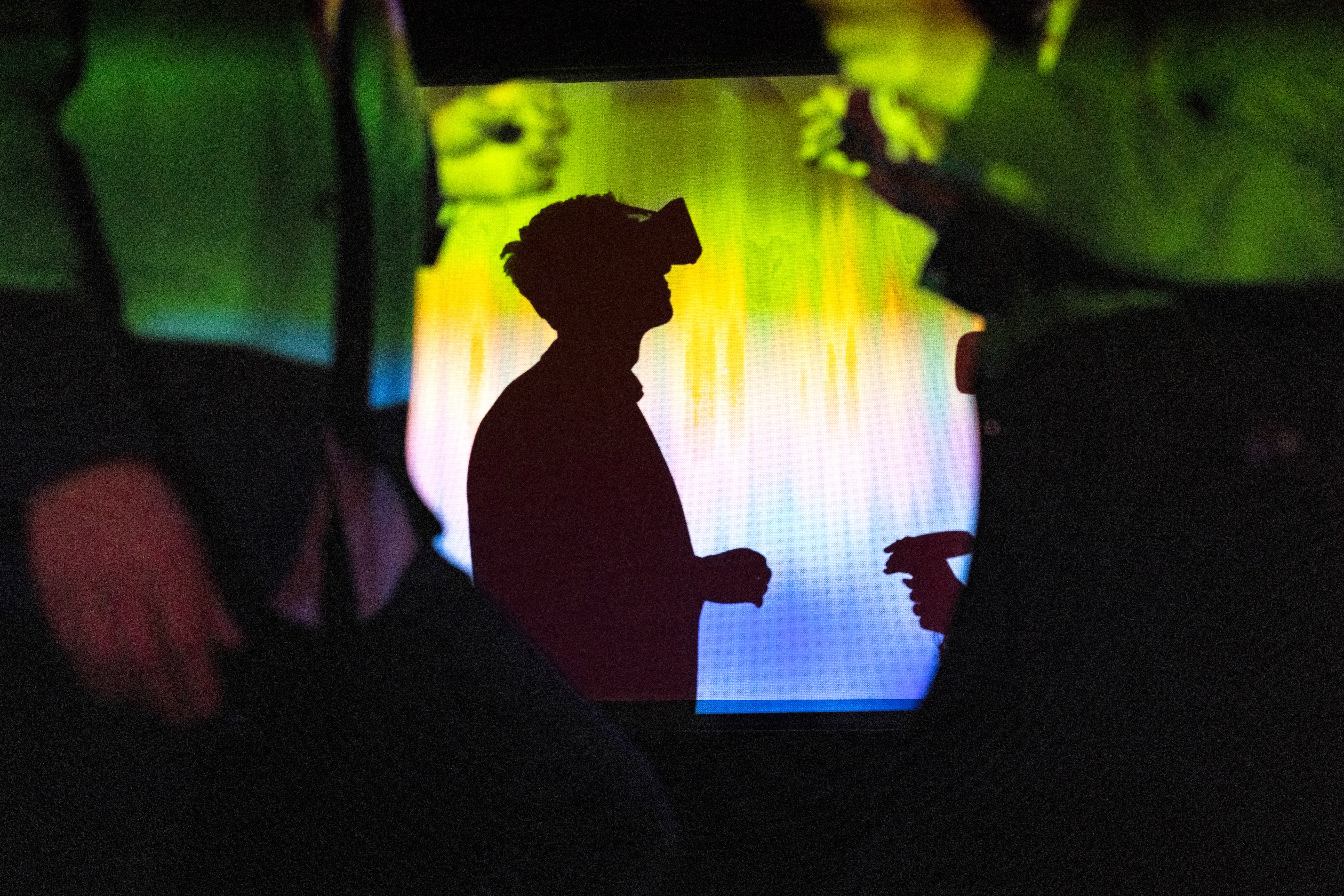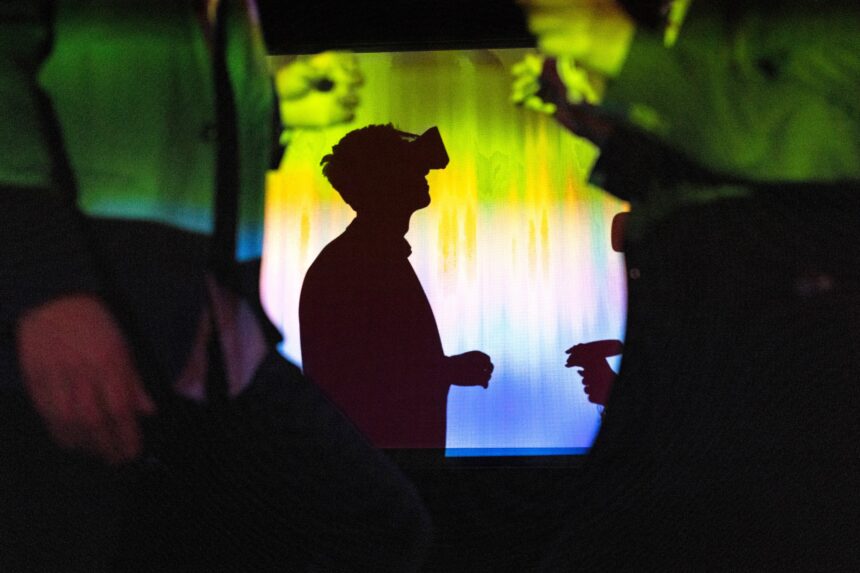
A young man enters a busy, dimly lit pub in Amsterdam alone to await the arrival of friends. A faint dance beat plays in the background. A drunken man approaches the bar and orders drinks in a loud, obnoxious manner. He proceeds to taunt the newcomer, burp in his face and bark, “What? Am I hitting on you or what?”
On a virtual-reality (VR) headset where this scene plays out, a question is superimposed on the screen: “How do you feel at this moment?” The headset-wearer, who is watching the scene from the point of view of the newcomer, can then shift their eyes to rate their level of disgust, anger, annoyance, fear, excitement and other emotions using a scale from one, “not at all,” to seven, “very much.”
This exercise is part of a study designed to decode how emotions influence criminal behavior, a research area that has been understudied in criminology, says Shaina Herman, a criminologist at the Max Planck Institute for the Study of Crime, Security and Law in Freiburg, Germany. “We are using virtual-reality technology where we can put participants in an immersive crime opportunity. The goal is to manipulate their real-time emotions,” Herman commented in a session on crime and justice decision-making on February 16 at the annual meeting of the American Association for the Advancement of Science (AAAS) in Denver, Colo. The simulation is designed to probe how a person makes the decision to react—to commit a crime, say, or to intervene to stop one—when confronted with an emotionally intense situation.
On supporting science journalism
If you’re enjoying this article, consider supporting our award-winning journalism by subscribing. By purchasing a subscription you are helping to ensure the future of impactful stories about the discoveries and ideas shaping our world today.
Herman’s work could help explain why people commit crimes in the heat of the moment—those such as second-degree murder, assault, domestic abuse and some types of theft. It shows that virtual environments can powerfully induce specific emotions such as anger or excitement, and it is a step toward determining how those emotions affect one’s willingness to perform a criminal act, such as starting a fight in a bar. Herman’s research is slated to appear in an upcoming issue of the Journal of Experimental Criminology.
Emotions unleashed by unforeseen circumstances can distort a person’s rational calculation of the cost of their actions—which can involve shame, say, or an estimation of the chances of getting caught—versus the benefits of the crime. They may help account for the fact that people who, based on their personality, seem exceedingly unlikely to commit a crime are actually capable at times of doing so. “Sometimes people can be very moral or have all these prosocial personality characteristics, and yet they will commit a crime,” Herman says. “Emotions could explain why that is.”
VR, this new work suggests, may help address how emotion affects decision-making that could lead to committing a criminal act. Criminologists cannot ethically conduct field experiments to study this question. “I can’t very well ask a study participant to go commit a crime and then, while he’s committing the crime, interview him about how he’s perceiving the situation [and his] emotions,” Herman said.
Criminologists have used written vignettes to place people at a scene, but such descriptions cannot convey subtle nonverbal cues—a rude hand gesture or icy stare—that can set someone off in real life. “It doesn’t necessarily feel real to life to read a description of a situation,” says Jessica Deitzer, a criminologist at the University of Nebraska Omaha, who was not involved with the new research. Another problem, Deitzer says, is that written vignettes leave a lot of details to the imagination, which introduces variation between subjects. The VR approach, she says, helps solve both problems. “It is very immersive, and you can imagine being in that situation. And it doesn’t leave things about the context up to chance,” she says.
Max Planck criminologist Jean-Louis van Gelder, who pioneered the use of VR in criminology a few years ago, tasked Herman and her husband, criminologist Timothy Barnum, with creating the bar-scene movies to show the utility of the technology in a controlled experiment. Herman and Barnum lined up producers, directors and actors, and in late 2021, they traveled to Amsterdam for three days of filming. They brought in German actors and filled a packed bar with Dutch extras. Once the films were produced, the researchers recruited more than 100 men aged 18 to 30 from bars, restaurants and universities in Freiburg for their experiment.
The participants watched one of three movies filmed with 360-degree picture and audio. Some of them watched the video that featured the obnoxious, drunken man, who was supposed to induce anger and annoyance. Others had an encounter designed to elicit sexual arousal or excitement. It featured a woman who walked up to the bar, made eye contact with the participant, gestured to him in a flirtatious manner and then ordered a beer for him, which she told the bartender to charge to her tab. A third group viewed a scene in which nothing remarkable happened.
The researchers found that the virtual scenes brought out the expected emotions—anger or arousal—based on participant ratings from before and after being immersed in the videos. The “anger” and “arousal” videos also produced stronger emotions of the intended type than the neutral video. The effects were huge, Herman says, as well as specific. “Not only can we use the virtual reality to change in-the-moment emotions but we can actually target which emotions we are trying to get at,” she says. As part of the study, monitoring equipment captured physiological responses, such as a spike in heart rate, that often accompany heightened emotions.
Herman and her colleagues have also gathered data, which has yet to be analyzed, on how anger or arousal affects the decision to start a fight or intervene in one or to put a stop to sexual harassment. For this part of the study, participants responded to additional footage. In the anger scenario, the drunken patron got in a shoving match with another man. He then sauntered back to the bar, grabbed the participant’s beer and took a swig while glaring at him. In the arousal episode, participants watched a patron aggressively hit on the woman from the earlier video, who became obviously upset as he blocked her path back to her table.
The researchers asked the participants questions about how these scenes, and their attendant emotions, influenced cognitive factors known to sway decisions on whether to commit a crime. These factors include perception of arrest risk, the morality of an aggressive or criminal act and the social benefits or risks of such action. For instance, a child might think that committing a crime makes them look cool—a social reward—but an adult might be concerned about how such behavior might look to others. “What we want to understand is how these emotional states change the way people perceive these cognitions, change the way they see risk [and] change the way they actually make decisions,” Herman says.
Herman’s work is part of broader trend in criminology that attempts to use principles of behavioral economics to get a handle on non-rational factors in decision-making in the context of crimes, said Greg Pogarsky, a criminologist at the University at Albany and former public defender, who also spoke in the AAAS session on crime. “We use intuitions, emotions and other visceral cues in the environment, and they actually affect our judgements,” he said in his talk. For example, when people feel good about an activity, they will tend to overestimate its benefits and underestimate the potential consequences, he says.
One intuitive factor that plays a role in errant police shootings, Pogarsky said, is “priming”—in this case, by a dispatcher. “It turns out that the information communicated by the dispatcher can affect the probability that there’s a mistaken police shooting,” Pogarsky said at the meeting. If a dispatcher utters the word “gun” in describing the scene, a responding officer is predisposed or “primed” to see a gun, even if what a suspect pulls out of their pocket is a wallet or cell phone. In one study that involved a simulated environment that was not VR, when the dispatcher said the assailant had a “gun,” the chances of a mistaken shooting doubled compared with instances when the dispatcher did not say the subject had a gun, Pogarsky said.
VR could be part of the solution in such situations, Herman suggested. The technology could be used to simulate heated scenarios and enable officers to practice their response, she said. Similarly, virtual simulations of stressful cross-examinations in a courtroom could help prepare crime victims or other witnesses to take the stand.
The bar-scene clips, which are in German, have been dubbed into English, Dutch and French, and Herman and her colleagues plan to make them widely available to researchers. The episodes may be in demand: at the American Society of Criminology meeting this past November, researchers waited in line to experience the immersive action, Deitzer says. The new results also underscore the usefulness of VR for understanding crime, inspiring Deitzer, for one, to consider using it to investigate how adolescents make decisions about committing crimes. “I think we’ll see more of it in the future,” she says.

